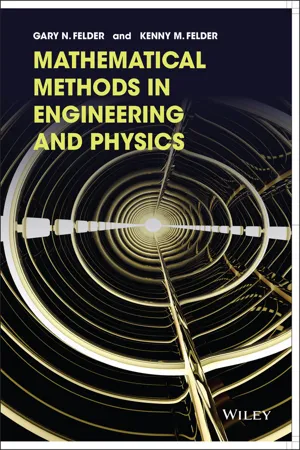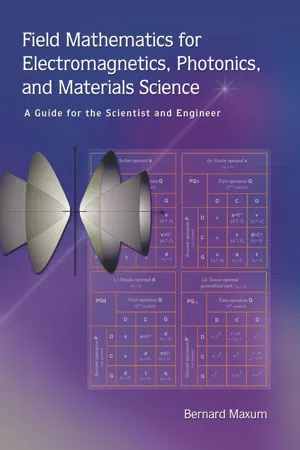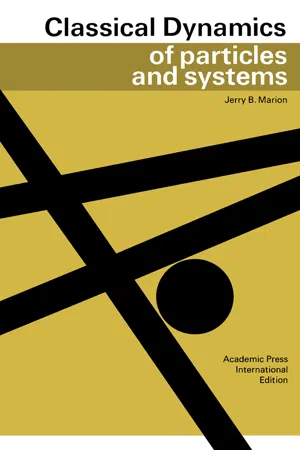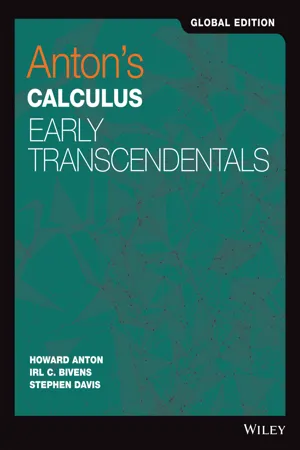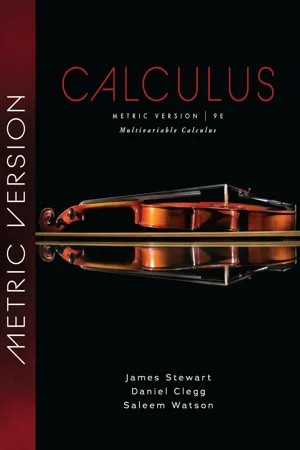Technology & Engineering
Divergence Vector Calculus
Divergence in vector calculus measures the rate at which a vector field's intensity spreads out from a given point. It is a scalar quantity that represents the volume density of the outward flux of a vector field per unit volume. In practical terms, divergence is used to analyze fluid flow, electric and magnetic fields, and other phenomena in engineering and technology.
Written by Perlego with AI-assistance
Related key terms
1 of 5
8 Key excerpts on "Divergence Vector Calculus"
- Adrian Burd(Author)
- 2019(Publication Date)
- Cambridge University Press(Publisher)
The divergence of v 1 is ∇ · v 1 = ∂ (−x ) ∂ x + ∂ (−y) ∂ y = −2; the vector field has a negative constant divergence and, as can be seen from Figure 7.7a, is converging toward the origin. For the vector field v 2 , we have ∇ · v 2 = ∂ ∂ x ( x + y) + ∂ ∂ y (−x + y) = 2, so v 2 is diverging from the origin (Figure 7.7b). Exercise 7.3.1 Calculate the divergence of the vector field v = −( x 2 − x )ˆ ı − ( y 2 − y)ˆ j and find the regions where the vector field is divergent and convergent. Vector fields with a positive divergence are often called sources and those with a negative divergence are often called sinks. The reason for this can be seen from Figure 7.7, where it appears that a field with a negative divergence (i.e., a convergent field) is disappearing and vice versa for a field with a positive divergence. If the vector field represents the flow of a physical variable such as the mass of a pollutant carried by water, then a positive divergence indicates the presence of a source of that pollutant and a negative divergence 417 7.3 Divergence and Curl indicates the presence of a sink. Such sources and sinks indicate the presence of reactions that create or remove the pollutant within the region of positive or negative divergence. For example, let us consider a conserved quantity such as the mass M of a pollutant in water. We can define a vector u = ρ( x , y, z )v( x , y, z ), where ρ is the density of the pollutant as a function of position and v is the velocity of the fluid. The vector u has dimensions of [M][L] −2 [T] −1 and is called a flux. We have seen that the divergence represents a rate of change of a vector per unit volume V , so we might suspect that there exists a relationship that looks something like ∂ M ∂t + S( x , y, z , t )V + ∇ · uV = 0 = ⇒ ∂ ρ ∂t + S( x , y, z , t ) + ∇ · (ρv) = 0, (7.12) where S( x , y, z , t ) represents the rate per unit volume of formation or removal of the pollutant; i.e., the net combination of sources and sinks.- Gary N. Felder, Kenny M. Felder(Authors)
- 2015(Publication Date)
- Wiley(Publisher)
Does the generalization “the formula for divergence tells how much the vector field flows away from a small region around this point” always hold up? (e) How would we extend this argument to two or three dimensions? 8.7 Divergence and Curl II—The Math Behind the Pictures We’re going to do two things in this section. First, we’re going to define more carefully what wemeanwhenwesaythedivergencemeasures“howmuchthefieldpointsawayfromapoint” and the curl measures “circulation around a point.” Second, we will show how you can use those definitions to derive the formulas we gave for the divergence and curl. 8.7.1 Explanation: Divergence and Curl II—The Math Behind the Pictures Divergence Describing divergence as “how much a vector field flows away from a given point” sounds good until you think hard about it. But at any given point, the vector field just has a certain magnitude and a certain direction. It certainly doesn’t point away from or toward itself; what matters is how much the nearby vectors point toward or away from our point. But how nearby is “near enough,” and how do we quantify all that? (x, y, z) (x + Δx, y, z) Δy Δx Δz FIGURE 8.14 A vector field flows through a box around the point (x, y, z). The answer begins with: draw a closed surface around the point, and measure the integral of the vector field through that surface. Do you remem- ber the convention for surface integrals through a closed surface? Every vector (or component thereof) pointing out through the surface counts positive toward the total. Vectors pointing inward count negative, and vectors pointing along the sur- face don’t count at all. All that is exactly what we want for the divergence. Take a moment to look at Figure 8.14 before reading further.- Maxum, Bernard(Authors)
- 2004(Publication Date)
That is, these vector fields are present at points in space for which there are no sources as long as at least one source at another position in space exists to cause the field in the first place. The shape of the field depends on the placement and distribution of the sources, the properties of the medium hosting the field, and the boundary constraints or boundary conditions . Figure 4.4-2 Graphical representation of a generalized vector field flux tube with nine field direction lines defining the side of the tube and three field direction lines shown in the interior of the flux tube. A B 4.4: The Divergence Differential Operator 4-19 Consider a given vector field F . Applying the techniques of Section 2.6, vector field direction lines (also called flow lines) can be graphed. Consider collecting an imaginary bundle of these flow lines into a tube whose sides are everywhere parallel to the flow lines truncated at ends by two surfaces A and B that intersect the bundle of flow lines not necessarily at right angles to them. Such a tube can be thought of as a field of flux flow lines or a flux tube . Figure 4.4-2 provides a pictorial representation of a vector field flux tube. Flux tubes have the characteristic that no flux penetrates the sides of the tube. Consider a volume to be made up of a section of a flux tube as shown. Therefore, the only flux entering or leaving the volume are through the cross-sectional end caps of the flux tube. If the same amount of flux enters the volume through end-cap A that leaves through end-cap B , then by the definition above, the divergence is said to be zero even though the field direction lines may be physically diverging or converging. It is possible for the divergence of a given vector field F not to be zero, that is, more flux enters through end cap A than leaves through end cap B , or vice versa. This can happen only if there is a distribution of sources in the volume of the tube, as we will observe.- Available until 16 Feb |Learn more
- Dean G. Duffy(Author)
- 2021(Publication Date)
- Chapman and Hall/CRC(Publisher)
This scalar quantity is called the divergence of the vector v : d i v (v) = ∇ · v = (∂ ∂ x i + ∂ ∂ y j + ∂ ∂ z k) · (u i + v j + w k) = u x + v y + w z. (4.2.6) Thus, if the divergence is positive, either the fluid is expanding and its density at the point is falling with time, or the point is a source at which fluid is entering the field. When the divergence is negative, either the fluid is contracting and its density is rising at the point, or the point is a negative source or sink at which fluid is leaving the field. If the divergence of a vector field is zero everywhere within a domain, then the flux entering any element of space exactly balances the flux leaving it and the vector field is called nondivergent or solenoidal (from a Greek word meaning a tube). For a fluid, if there are no sources or sinks, then its density cannot change. Some useful properties of the divergence operator are ∇ · (F + G) = ∇ · F + ∇ · G, (4.2.7) ∇ · (φ F) = φ ∇ · F + F · ∇ φ (4.2.8) and ∇ 2 φ = ∇ · ∇ φ = φ x x + φ y y + φ z z. (4.2.9) Equation 4.2.9 is very important in physics and is given the special name of the Laplacian. 3 3 Some mathematicians write Δ instead of ∇ 2. • Example. 4.2.1 If F = x 2 z i − 2 y 3 z 2 j + xy 2 z k, compute the divergence of F. ∇ · F = ∂ ∂ x (x 2 z) + ∂ ∂ y (− 2 y 3 z 2) + ∂ ∂ z (x y 2 z) = 2 x z − 6 y 2 z 2 + x y 2. (4.2.10) • Example. 4.2.2 If r = x i + y j + z k, show that r /| r | 3 is. nondivergent. ∇ · (r | r | 3) = ∂ ∂ x [ x (x 2 + y 2 + z 2) 3 / 2 ] + ∂ ∂ y [ y (x 2 + y 2 + z 2) 3 / 2 ] + ∂ ∂ z [ z (x 2 + y 2 + z 2) 3 / 2 ] (4.2.11) = 3 (x 2 + y 2 + z 2[--=PLGO-SEPARATO. R=--]) 3 / 2 − 3 x 2 + 3 y 2 + 3 z 2 (x 2 + y 2 + z 2) 5 / 2 = 0. (4.2.12) Another important vector function involving the vector field v is the curl of v, written curl(v) or rot(v) in some older textbooks. In fluid flow problems it is proportional to the instantaneous angular velocity of a fluid element - eBook - PDF
- Jerry B. Marion(Author)
- 2013(Publication Date)
- Academic Press(Publisher)
Since the temperature and pressure may vary from point to point* within the medium, a temperature gradient or pressure gradient will in general exist. Similarly, if a physical quantity has both magnitude and direction defined at every point in space, the quantity may be described by a vector field. Thus, the electric field vector E(x t ) or the velocity vector v(Xj) of the flow in a fluid define vector fields. In a mathematical sense, a scalar field is defined in terms of a function which may be completely specified by only one number at every point in space. A vector field is defined in terms of a function which is completely specified by three numbers! at every point in space ; the functions which yield these numbers must, of course, obey the correct transformation law. The divergence and the curl are operators which act on vectors that define vector fields. Let A = A(x;) be a vector that defines a certain vector field. The diver-gence of A is defined as the scalar product of the gradient operator and the vector A : r w rdxi (2.54) The physical meaning of the divergence of a vector quantity may be seen by considering, for example, the flow of a fluid. Consider a volume element dv = dx x dx 2 dx 3 whose faces are normal to the three axes. Let the vector A represent the rate of flow (per unit area) of a fluid through a face normal to A. The component A l is shown in Fig. 2-6 and represents the rate of flow (per unit area) in the x r direction through the area dx 2 dx 3 at the position of the plane defined by x l . If A l changes between x x and x x + dx u then the rate of flow (per unit area) through the area dx 2 dx 3 at the position of the plane defined by Χχ + dxi may be expressed by a Taylor series : dA A l {x 1 + dxj = A^xJ + j ^ dx 1 + ··· (2.55) * According to kinetic theory, temperature and pressure are macroscopic concepts and therefore do not exist for mathematical points. - eBook - PDF
Anton's Calculus
Early Transcendentals
- Howard Anton, Irl C. Bivens, Stephen Davis(Authors)
- 2018(Publication Date)
- Wiley(Publisher)
Use a CAS to verify Formula (1) in the Divergence Theorem for the vector field F = (x 2 y − z 2 )i + (y 3 − x) j + (2x + 3z − 1)k by evaluating the surface integral and the triple integral. 38. Writing Discuss what it means to say that the divergence of a vector field is independent of a coordinate system. Explain how we know this to be true. 39. Writing Describe some geometrical and physical applica- tions of the Divergence Theorem. QUICK CHECK ANSWERS 15.7 1. ∫ ∫ F ⋅ n dS; ∫ ∫ ∫ G div F d V 2. 3 3. source; sink; div F = 0 4. 4c; 0 15.8 STOKES’ THEOREM In this section we will discuss a generalization of Green’s Theorem to three dimensions that has important applications in the study of vector fields, particularly in the analysis of rotational motion of fluids. This theorem will also provide us with a physical interpre- tation of the curl of a vector field. RELATIVE ORIENTATION OF CURVES AND SURFACES We will be concerned in this section with oriented surfaces in 3-space that are bounded by simple closed parametric curves (Figure 15.8.1a). If is an oriented surface bounded by a simple closed parametric curve C, then there are two possible relationships between the orientations of and C, which can be described as follows. Imagine a person walking along the curve C with his or her head in the direction of the orientation of . The person is said to be walking in the positive direction of C relative to the orientation of if the surface is on the person’s left (Figure 15.8.1b), and the person is said to be walking in the negative direction of C relative to the orientation of if the surface is on the person’s right (Figure 15.8.1c). The positive direction of C establishes a right-hand relationship between the orientations C ( b) ( a) ( c) σ The oriented surface σ is bounded by the simple closed curve C. The positive direction of C relative to the orientation of σ. The negative direction of C relative to the orientation of σ. Figure 15.8.1 - James Stewart, Daniel K. Clegg, Saleem Watson, , James Stewart, James Stewart, Daniel K. Clegg, Saleem Watson(Authors)
- 2020(Publication Date)
- Cengage Learning EMEA(Publisher)
All Rights Reserved. May not be copied, scanned, or duplicated, in whole or in part. Due to electronic rights, some third party content may be suppressed from the eBook and/or eChapter(s). Editorial review has deemed that any suppressed content does not materially affect the overall learning experience. Cengage Learning reserves the right to remove additional content at any time if subsequent rights restrictions require it. SECTION 16.5 Curl and Divergence 1167 Another differential operator occurs when we compute the divergence of a gradient vector field = f . If f is a function of three variables, we have divs = f d - = s = f d - - 2 f -x 2 1 - 2 f -y 2 1 - 2 f -z 2 and this expression occurs so often that we abbreviate it as = 2 f . The operator = 2 - = = is called the Laplace operator because of its relation to Laplace’s equation = 2 f - - 2 f -x 2 1 - 2 f -y 2 1 - 2 f -z 2 - 0 We can also apply the Laplace operator = 2 to a vector field F - P i 1 Q j 1 R k in terms of its components: = 2 F - = 2 P i 1 = 2 Q j 1 = 2 R k ■ Vector Forms of Green’s Theorem The curl and divergence operators allow us to rewrite Green’s Theorem in versions that will be useful in our later work. We suppose that the plane region D, its boundary curve C, and the functions P and Q satisfy the hypotheses of Green’s Theorem. Then we con- sider the vector field F - P i 1 Q j. Its line integral is y C F dr - y C P dx 1 Q dy and, regarding F as a vector field on R 3 with third component 0, we have curl F - i j k - -x - -y - -z Ps x, yd Qs x, yd 0 - S -Q -x 2 -P -y D k Therefore scurl Fd k - S -Q -x 2 -P -y D k k - -Q -x 2 -P -y and we can now rewrite the equation in Green’s Theorem in the vector form 12 y C F dr - y C F T ds - y D y scurl Fd k dA Equation 12 expresses the line integral of the tangential component of F along C as the double integral of the vertical component of curl F over the region D enclosed by C.- eBook - PDF
- James Stewart, Daniel K. Clegg, Saleem Watson, , James Stewart, James Stewart, Daniel K. Clegg, Saleem Watson(Authors)
- 2020(Publication Date)
- Cengage Learning EMEA(Publisher)
All Rights Reserved. May not be copied, scanned, or duplicated, in whole or in part. Due to electronic rights, some third party content may be suppressed from the eBook and/or eChapter(s). Editorial review has deemed that any suppressed content does not materially affect the overall learning experience. Cengage Learning reserves the right to remove additional content at any time if subsequent rights restrictions require it. SECTION 16.5 Curl and Divergence 1167 Another differential operator occurs when we compute the divergence of a gradient vector field = f . If f is a function of three variables, we have divs = f d - = s = f d - - 2 f -x 2 1 - 2 f -y 2 1 - 2 f -z 2 and this expression occurs so often that we abbreviate it as = 2 f . The operator = 2 - = = is called the Laplace operator because of its relation to Laplace’s equation = 2 f - - 2 f -x 2 1 - 2 f -y 2 1 - 2 f -z 2 - 0 We can also apply the Laplace operator = 2 to a vector field F - P i 1 Q j 1 R k in terms of its components: = 2 F - = 2 P i 1 = 2 Q j 1 = 2 R k ■ Vector Forms of Green’s Theorem The curl and divergence operators allow us to rewrite Green’s Theorem in versions that will be useful in our later work. We suppose that the plane region D, its boundary curve C, and the functions P and Q satisfy the hypotheses of Green’s Theorem. Then we con- sider the vector field F - P i 1 Q j. Its line integral is y C F dr - y C P dx 1 Q dy and, regarding F as a vector field on R 3 with third component 0, we have curl F - i j k - -x - -y - -z Ps x, yd Qs x, yd 0 - S -Q -x 2 -P -y D k Therefore scurl Fd k - S -Q -x 2 -P -y D k k - -Q -x 2 -P -y and we can now rewrite the equation in Green’s Theorem in the vector form 12 y C F dr - y C F T ds - y D y scurl Fd k dA Equation 12 expresses the line integral of the tangential component of F along C as the double integral of the vertical component of curl F over the region D enclosed by C.
Index pages curate the most relevant extracts from our library of academic textbooks. They’ve been created using an in-house natural language model (NLM), each adding context and meaning to key research topics.

